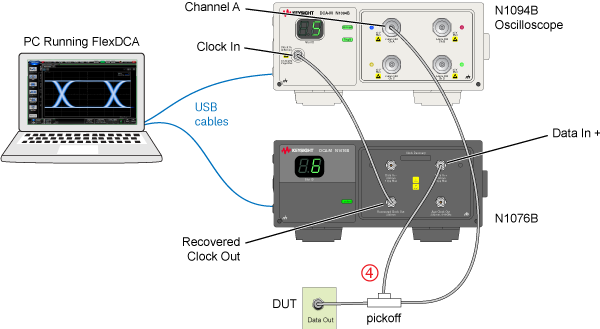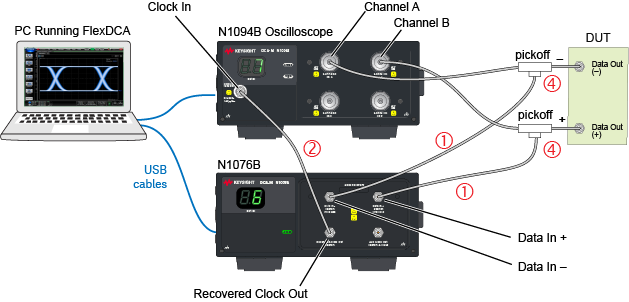N1076A/B Electrical CDR Test Setups
The illustrations in this topic represent a variety of electrical clock recovery using the N1076/7A. In some situations, the length of the cables used can impact measurement accuracy. For more information, download the N1076/7A user's guide at www.keysight.com.
Circled numbers in this figure identify items from the electrical phase matching kits. Optional equalizers can be added to open a closed eye for clock recovery.
Precision Timebase and Trigger Connections from an N107x-Series DCA-M
When using an N107x-series DCA-M clock recovery module with an N1060A or 86108A/B, know that the signal from the N107x's Aux Clock Out connector has significantly lower jitter than the signal from the N107x's Recovered Clock Out connector. Therefore:
- Connect the N107x's Aux Clock Out (lower jitter) to the DCA-X's or N1060A's Precision Timebase Input, and
- Connect the N107x's Recovered Clock Out to the DCA-X's Trigger Input.
Example Setup 1. Single-Ended Input with DCA-M Scope
This example setup shows an N1076A/B connected to an N1094B oscilloscope with a single-ended electrical input signal. A microwave pickoff is used to tap a portion of the input signal as an input to the clock recovery module.

Example Setup 2. Differential Input with DCA-M Scope
This example setup shows an N1076A/B connected to an N1094B oscilloscope with a differential input signal. Two microwave pickoffs are used to tap a portion of the input signal as an input to the clock recovery module.

Example Setup 3. Differential Input with DCA-X Scope
This example setup shows an N1076A/B connected to a DCA-X scope, which has an N1045A receiver module and an 86107A precision timebase. Two microwave pickoffs are used to tap a portion of the input signal as an input to the clock recovery module.
